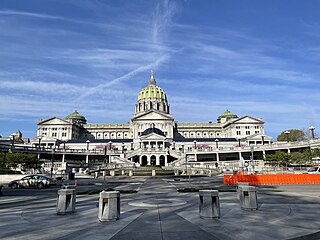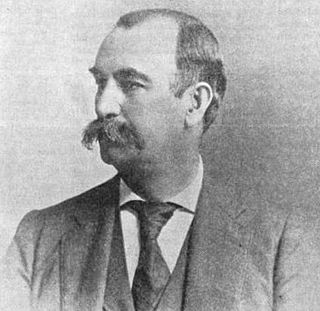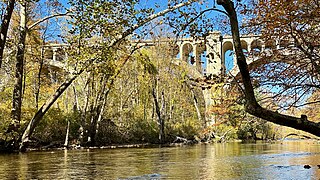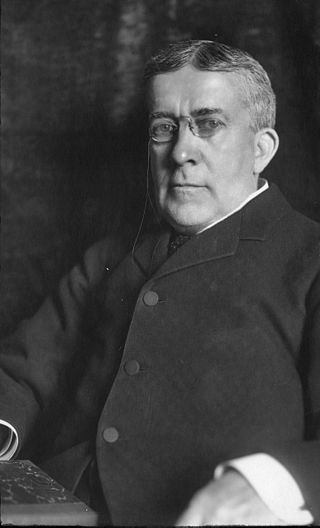Related Research Articles

Upper Darby Township, often shortened to Upper Darby, is a home rule township in Delaware County, Pennsylvania, United States. As of the 2020 census, the township had a total population of 85,681, making it the state's sixth-most populated municipality after Philadelphia, Pittsburgh, Allentown, Reading, and Erie. Upper Darby borders Philadelphia, the nation's sixth-most populous city, and constitutes part of the Delaware Valley, also known as the Philadelphia metropolitan area, the nation's seventh-largest metropolitan area.

Cyrus Edwin Dallin was an American sculptor best known for his depictions of Native Americans. He created more than 260 works, including the Equestrian Statue of Paul Revere in Boston; the Angel Moroni atop Salt Lake Temple in Salt Lake City; and Appeal to the Great Spirit (1908), at the Museum of Fine Arts, Boston. He was also an accomplished painter and an Olympic archer.

William Scott Vare was an American politician from Pennsylvania who served as a Republican member of the United States House of Representatives for Pennsylvania's 1st congressional district from 1912 to 1927. He also served as a member of the Pennsylvania State Senate from the 1st Senatorial District from 1922 to 1923. He won election to the United States Senate for Pennsylvania in 1926 but was never seated and was eventually removed in 1929 due to allegations of corruption and voter fraud.

Michael Leib was an American physician and politician from Philadelphia. He served as a surgeon in the Philadelphia Militia during the American Revolutionary War. He served as a Democratic-Republican member of the Pennsylvania House of Representatives three times; from 1795 to 1798, 1806 to 1808 and 1817 to 1818. He served as a member of the United States House of Representatives for Pennsylvania's 2nd congressional district from 1799 to 1803 and for Pennsylvania's 1st congressional district from 1803 to 1806. He served as a member of the United States Senate for Pennsylvania from 1809 to 1814. He also served as a member of the Pennsylvania State Senate for the 1st district from 1818 to 1821.

The Pennsylvania State Capitol is the seat of government for the U.S. state of Pennsylvania located in downtown Harrisburg. The building was designed by architect Joseph Miller Huston in 1902 and completed in 1906 in a Beaux-Arts style with decorative Renaissance themes throughout. The capitol houses the legislative chambers for the Pennsylvania General Assembly, made up of the House of Representatives and the Senate, and the Harrisburg chambers for the Supreme and Superior Courts of Pennsylvania, as well as the offices of the Governor and the Lieutenant Governor. It is also the main building of the Pennsylvania State Capitol Complex.

John Edgar Reyburn was an American politician who served as a Republican member of the U.S. House of Representatives for Pennsylvania's 4th congressional district from 1890 to 1897 and Pennsylvania's 2nd congressional district from 1906 to 1907. He served as a member of the Pennsylvania House of Representatives in 1871 and again from 1874 to 1876. He served as a member of the Pennsylvania State Senate from 1876 to 1890 including as president pro tempore in 1883. He served as Mayor of Philadelphia from 1907 to 1911.

William Stuart Reyburn was an American politician who served as a Republican member of the U.S. House of Representatives for Pennsylvania's 2nd congressional district from 1911 to 1913. He served as a member of the Pennsylvania House of Representatives for Philadelphia County from 1909 to 1911.

Horace Trumbauer was a prominent American architect of the Gilded Age, known for designing residential manors for the wealthy. Later in his career he also designed hotels, office buildings, and much of the campus of Duke University.

The Paulinskill Viaduct, also known as the Hainesburg Viaduct, is a reinforced concrete railroad bridge that crosses the Paulins Kill in Knowlton Township, New Jersey. When completed in 1910, it was the largest reinforced concrete structure in the world.

Theophilus Parsons Chandler Jr. was an American architect of the late 19th and early 20th centuries. He spent his career at Philadelphia, and is best remembered for his churches and country houses. He founded the Department of Architecture at the University of Pennsylvania (1890), and served as its first head.

Charles Custis Harrison was an American businessman who owned several sugar refineries in Philadelphia from 1863 to 1892, and served as Provost of the University of Pennsylvania from 1894 to 1910.
Gerald Patrick Aloysius O'Hara was an American prelate of the Catholic Church. He served as an auxiliary bishop in the Archdiocese of Philadelphia (1929–1935), as bishop of the Diocese of Savannah in Georgia (1935–1959), as papal regent to Romania (1947–1950), apostolic nuncio to Ireland (1951–1954), and as apostolic delegate to Great Britain (1954–1963).

John Morin Scott was an American politician who served as a Whig Party member of the Pennsylvania House of Representatives from 1815 to 1816, and again in 1839. He served several terms in the Common and Select Councils for Philadelphia and as president of the Select Council for Philadelphia from 1826 to 1832.

Matthew Newkirk was an American businessman, railroad magnate, banker and philanthropist. He was president of the Philadelphia, Wilmington and Baltimore Railroad (PW&B) and led the integration of four railroad companies to establish the first direct rail service between Philadelphia and Baltimore. He was a director of the Second Bank of the United States; and an investor in the Little Schuylkill Navigation, Railroad and Coal Company and the Cambria Iron Company.
David Williamson Flickwir (1852-1935) was a civil engineer and railroad engineering contractor. His company built one of the world's largest concrete bridges, the Tunkhannock Viaduct.

Cheltenham Township is a home rule municipality and Township of the First Class located in the southeast corner of Montgomery County, Pennsylvania, United States. It borders Philadelphia to the south and east, Abington Township and Jenkintown to the north, and Springfield Township to the west.

The 1911 Philadelphia mayoral election saw the election of Rudolph Blankenburg.

Harry W. Bass was an American lawyer and politician who became the first African American to serve in the Pennsylvania House of Representatives, winning two consecutive terms in 1911 and 1913 to represent the sixth district of Philadelphia.
References
- 1 2 Center, Legislativate Data Processing. "HARRY F. CURTIS". The official website for the Pennsylvania General Assembly. Retrieved 2017-11-10.
- ↑ Dana, Richard Turner; William Lawrence Saunders; Construction Service Company (1911). Rock drilling: with particular reference to open cut excavation and submarine rock removal. J. Wiley & Sons. pp. 107–115. Retrieved November 15, 2012.
- ↑ Miller, Herman P.; W. Harry Bake (1910). "Smull's Legislative Hand Book and Manual of the State of Pennsylvania". Biographical Sketch. The State of Pennsylvania. p. 979. Retrieved November 19, 2012.